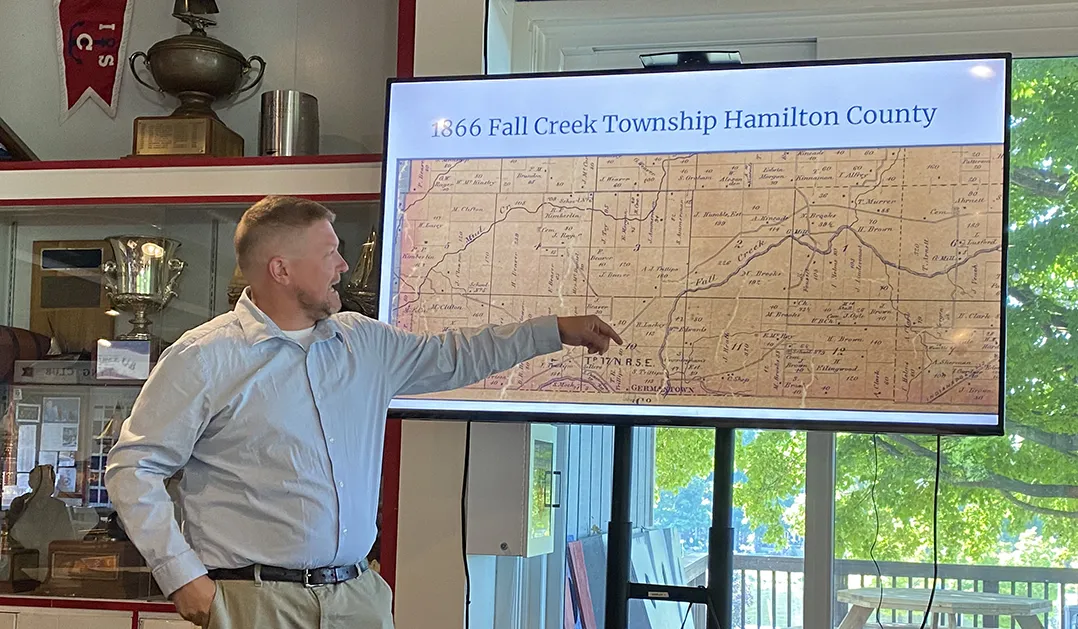Most people in the Geist Reservoir area are aware that a former town was flooded to create the lake, but Fishers Historical Society Historian Robert Bowling has delved deep into the history of what used to be Germantown, which was founded in the 1830s and sacrificed almost exactly 100 years later.
Bowling, who has written a book on the topic, gave a presentation about Germantown and Geist Reservoir during a special event at the Indianapolis Sailing Club. He spoke to a group of about 50 who attended to learn some local history and showed a series of slides with photos of Germantown and its residents, along with maps that pinpoint exactly where the former town was located.
Bowling said Germantown was founded March 1, 1834, by three brothers from Ohio: John, Solomon and George Beaver.
“There’s a competing story that Germantown was founded by a group of people from Oaklandan (who left because) they were upset (about) the killing of a Native American,” Bowling said. “We don’t believe that story is true. We believe that might have been like an old wives’ tale that was passed down. It seems more plausible through different researchers that the Beaver brothers were the ones who actually founded Germantown.”
Germantown straddled the Marion and Hamilton county line, he said, and on the Marion County side was the first town established in Lawrence Township.
“There were 20 homes in Germantown, on either side of the county line,” Bowling said. “They did have stuff like a general store, a blacksmith shop, offices, a post office, shoe repair shop and they also had a sawmill. So, it was a pretty good-sized town.”
It wasn’t easy getting in or out of Germantown.
“One thing about Germantown, when it was in its heyday, there was only one bridge crossing Fall Creek,” Bowling said. “It was a swinging footbridge and that’s all they had. It wasn’t until I think 1902 that they installed a bridge that could also accommodate horses. (Before that), if you had a horse and carriage, to get across Fall Creek you had to go across at the lowest point of the water. During the winter, it would get so icy that you could actually take your horse and buggy across the ice to get over.”
Bowling’s maps included names of people who owned property in Germantown. Some of the last names were familiar, either because descendants still live in the area or locations have been named for those families. The names included Beaver, Kinkaid and Brooks.
Starting in 1929, the Indianapolis Water Co. started quietly buying up large pieces of property around Germantown at low prices, even for that time. Eventually, it was revealed that the area was destined to become a reservoir to serve the water needs for a rapidly growing Indianapolis. Clarence Geist owned the company. The reservoir, which he started planning for following a 1923 water study, was named for him.
Construction of the reservoir was completed in 1943.
Bowling addressed some of the common myths about Germantown and Geist Reservoir.
“I can’t tell you how many times that I’ve heard somebody go, ‘Man, there’s a church steeple underneath the water,’” he said. “I’m like, ‘No, there isn’t.’ All the homes were demolished, taken apart. Most of the wood actually went to Fortville. There was a mill, and that’s where most of that wood was repurposed and used.”
If there were anything left from Germantown buildings, he said, it would be brick foundations, but they would be buried in mud.
Another myth is that a cemetery, with remains, is under the water. Bowling said that, too, is inaccurate. If there had been a cemetery, he said, any bodies would have been moved before construction began.
Bowling added that for about a decade after the reservoir opened, recreational activity and development were prohibited at Geist Reservoir. Water company officials changed their rules after the Indiana Department of Natural Resources threatened to declare the area a state park.
For more local history, visit fishershistory.com or facebook.com/fishershistoricalsociety.
